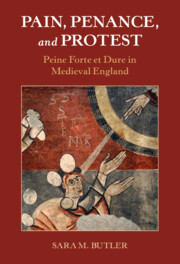Book contents
- Pain, Penance, and Protest
- Studies in Legal History
- Pain, Penance, and Protest
- Copyright page
- Contents
- Tables
- Acknowledgments
- Table of Statutes
- Abbreviations
- Introduction
- 1 Peine Forte et Dure: The Medieval Practice
- 2 Standing Mute in the Courts of Medieval England
- 3 Due Process and Consent to Jury Trial
- 4 Peine Forte et Dure as Barbarity? Putting the Practice in Context
- 5 Why Stand Mute?
- 6 Standing Mute as Imitatio Christi
- 7 Rejecting the Jury, Rejecting the Common Law, Rejecting the King
- Conclusion
- Bibliography
- Index
7 - Rejecting the Jury, Rejecting the Common Law, Rejecting the King
Published online by Cambridge University Press: 19 November 2021
- Pain, Penance, and Protest
- Studies in Legal History
- Pain, Penance, and Protest
- Copyright page
- Contents
- Tables
- Acknowledgments
- Table of Statutes
- Abbreviations
- Introduction
- 1 Peine Forte et Dure: The Medieval Practice
- 2 Standing Mute in the Courts of Medieval England
- 3 Due Process and Consent to Jury Trial
- 4 Peine Forte et Dure as Barbarity? Putting the Practice in Context
- 5 Why Stand Mute?
- 6 Standing Mute as Imitatio Christi
- 7 Rejecting the Jury, Rejecting the Common Law, Rejecting the King
- Conclusion
- Bibliography
- Index
Summary
Resistance to the state is the theme of the final chapter. Chapter 7 contends that reluctant defendants were rejecting the trial jury; however, it was not the mechanism they resented, but rather what it symbolized. Today, the jury stands as an emblem of rationalism and modernity. That is not how the medieval world saw it. After Henry II, English rule meant government by jury; in this atmosphere, the jury – whose membership tended to be highly selective – represented not freedom, equality, or modernity, but royal overreach. Standing mute was one among a number of weapons belonging to the peasantry’s arsenal to protest the growing power of the king, whose authority expanded at the expense of his subjects’ rights. Passive noncooperation typified peasant strategies of resistance, which included also failure to perform labor services, ignoring summons to appear for jury duty, and rent strikes, as well as listening to outlaw tales, applauding the sermons of rebellious priests, and venerating at the shrines of political martyrs. These were the more usual weapons of popular resistance. Standing mute should take its place in this category.
- Type
- Chapter
- Information
- Pain, Penance, and ProtestPeine Forte et Dure in Medieval England, pp. 348 - 397Publisher: Cambridge University PressPrint publication year: 2021

